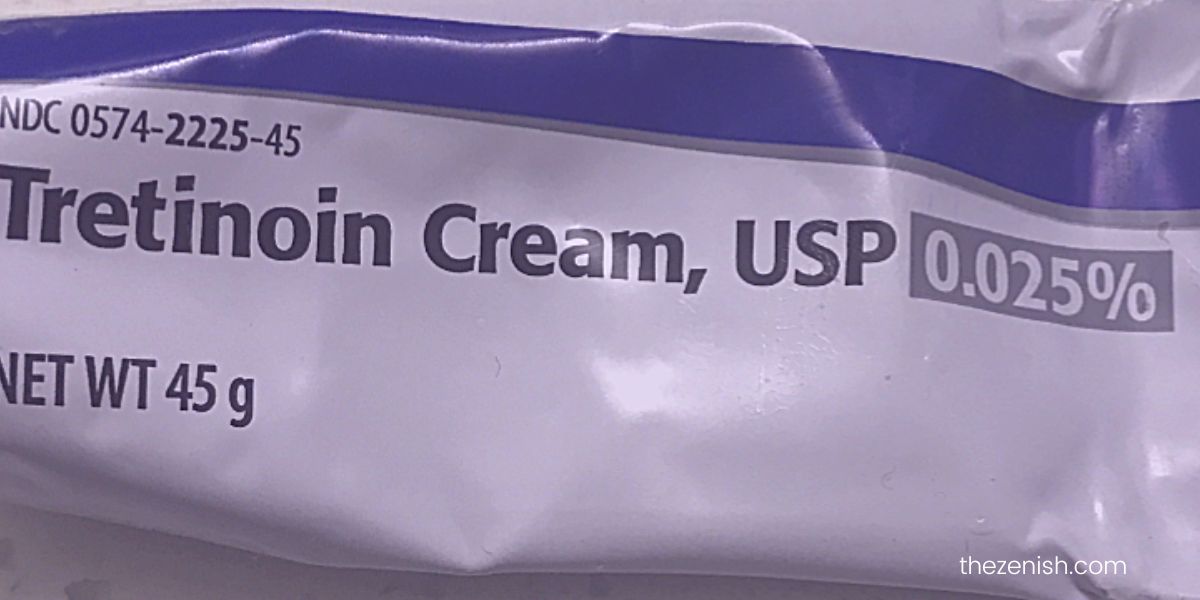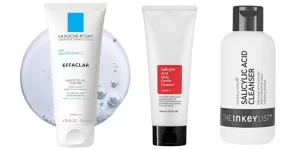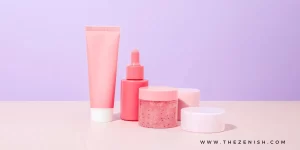
The inevitable march of time.
We all know it’s coming, but that doesn’t make it any easier to accept. Wrinkles, fine lines, and other signs of aging are just part of the package, right?
Well, not necessarily. Enter tretinoin, a skincare ingredient that promises to turn back the clock (or at least slow it down a little).

But what exactly is tretinoin, how does tretinoin work for fine wrinkles and anti aging and why is it so popular in the anti-aging world?
How does tretinoin work for wrinkles and anti aging
Let’s talk about skin aging for a sec. As you age, your skin’s collagen and elastin production start to slow down, making it less firm and elastic.
Throw in some UV damage and other environmental factors, and you’ve got yourself some wrinkles, sunspots, and a whole host of other uninvited guests.
Not exactly a party we want to attend, right?
Enter topical retinoids, a family of vitamin A derivatives that have been shown to improve skin texture, reduce fine lines, and even out skin tone.
Tretinoin is a specific type of retinoid otherwise known as retin A that works by increasing cell turnover in the skin.
Basically, it encourages your skin cells to work harder and faster, shedding the old and damaged ones and replacing them with fresh, new ones.
The mechanism behind tretinoin is pretty cool, too. It binds to specific receptors in your skin cells, activating them to produce more collagen and elastin.
It also helps to increase blood flow to your skin, which can improve overall texture and tone, it’s like a personal trainer for your skin cells, helping them to work harder and smarter.
So, how exactly does tretinoin work its anti-aging magic?
Well, it all comes down to a few key factors.
#1 Collagen production
Collagen is a protein that gives your skin its firmness and elasticity, but unfortunately, it tends to break down as you age.
See also: Best anti aging products for your 20s to slow the signs of aging
Tretinoin has been shown to help stimulate collagen production, which can help improve the overall texture and firmness of your skin.
#2 Skin cell turnover
As you age, your skin’s natural ability to shed dead skin cells and generate new ones slows down.
This can lead to a buildup of dead skin cells on the surface of your skin, which can make it look dull and contribute to the appearance of wrinkles and fine lines.
Tretinoin helps speed up your skin cell turnover process, which can help improve the overall texture and tone of your skin.
#3 Reducing fine lines and wrinkles
And finally, tretinoin cream has been shown to be effective in reducing the appearance of fine lines and wrinkles.
Likely due to its ability to boost collagen production and skin cell turnover, as well as its ability to increase the thickness of the skin.
Benefits of using tretinoin for wrinkles and anti-aging
Using tretinoin for wrinkles and anti-aging has a whole host of benefits that can help you achieve the smooth, youthful-looking skin you want. Here’s what you can expect:
#1 Improved skin texture
As we age, our skin can become rough and uneven, but tretinoin helps to stimulate collagen production and increase skin cell turnover, which can lead to smoother, more even skin.
#2 Reduced hyperpigmentation
Another benefit of using tretinoin is that it can help reduce hyperpigmentation.
Hyperpigmentation is when certain areas of your skin darken more than others, and it can be caused by a variety of factors, including sun exposure and hormonal changes.
Tretinoin can help lighten these dark spots and even out your skin tone.
#3 Prevent future wrinkles
And perhaps best of all, tretinoin can actually help prevent future wrinkles from forming.
By increasing collagen production and skin cell turnover, tretinoin can help keep your skin looking plump and firm, which can reduce the appearance of fine lines and prevent new ones from forming.
All in all, the benefits of using tretinoin for wrinkles and anti-aging are hard to beat.
But don’t just take my word for it – there have been plenty of clinical studies to back up tretinoin’s effectiveness.
In one study, participants who used tretinoin for 24 weeks saw a significant improvement in the appearance of fine lines and wrinkles, as well as an increase in skin firmness and elasticity.
And the longer you use it, the better the results – another study found that after two years of consistent tretinoin use, participants had significantly fewer wrinkles and sunspots than those who didn’t use tretinoin.
But how does tretinoin stack up against other anti-aging treatments? Well, let’s just say it’s pretty much the gold standard.
While other treatments may provide some short-term improvement, tretinoin’s long-term effects are hard to beat. Plus, it’s generally well-tolerated and has been shown to be safe for long-term use.
So, if you’re looking for a powerhouse anti-aging ingredient, tretinoin is definitely worth considering.
How to use tretinoin as part of your skincare routine
Ready to give tretinoin a try?
Great!
But before you jump in headfirst, here are a few things to keep in mind.
#1 Start slow
First and foremost, it’s important to start slow.
Tretinoin can be quite powerful, especially if you’ve never used it before, so it’s a good idea to start with a lower concentration and work your way up over time.
This will help minimize any potential side effects and allow your skin to adjust gradually.
It’s also a good idea to avoid other potentially irritating ingredients (like benzoyl peroxide or salicylic acid) while using tretinoin.
When it comes to application, less is more. A pea-sized amount is all you need for your entire face.
And wait at least 20-30 minutes after washing your face before applying tretinoin – you want your skin to be completely dry to avoid any potential irritation.
As for dosage and frequency, it’s best to follow your dermatologist’s recommendations, but In general, you’ll want to start with a lower concentration (like 0.025%) and gradually work your way up as your skin becomes more tolerant.
And don’t be tempted to use it more often than recommended (usually 2 – 3 times a week in the beginning, working up to daily use) – overuse can actually be counterproductive and lead to more irritation.
Patience is key – the results may not be immediate, but they’re well worth it.
#2 Don’t forget to use a moisturizer
Tretinoin can be quite drying, so it’s important to keep your skin hydrated to prevent any flakiness or irritation.
Use a gentle, non-comedogenic moisturizer after applying tretinoin to help lock in moisture and keep your skin looking and feeling smooth.
#3 Don’t forget to use sunscreen
And finally, always, always, always use sunscreen when using tretinoin, whether you’re using it during the summer or winter months.
Tretinoin can make your skin more sensitive to the sun, so it’s important to protect your skin with a broad-spectrum SPF of 30 or higher.
This will help prevent further damage to your skin and keep it looking its best.
Potential side effects when using tretinoin for wrinkles
As with any skincare treatment, tretinoin does come with a few potential side effects. But most are fairly mild and can be managed with a little TLC.
Here’s what you look out for:
Dryness and peeling
The most common side effects are dryness, flakiness, and redness, especially in the first few weeks of treatment.
This is because tretinoin works by increasing skin cell turnover, which can cause the top layer of your skin to flake off.
To combat this, it’s important to use a gentle, hydrating moisturizer after applying tretinoin to help keep your skin hydrated and prevent any flakiness.
Redness and irritation
Another potential side effect of tretinoin is redness and irritation. This is more likely to occur if you have sensitive skin or if you’re using a higher concentration of tretinoin.
If you do experience redness or irritation, try using a lower concentration of tretinoin or spacing out your applications to every other day.
And as always, be sure to use a gentle, non-irritating cleanser to avoid further irritation.
To minimize side effects start slow and be patient. Start with a lower concentration and gradually work your way up as your skin becomes more tolerant.
And don’t forget to moisturize! A good moisturizer can help combat dryness and flakiness.
More severe side effects can occur like severe redness, blistering, and peeling. If you experience any of these, it’s important to stop using tretinoin and contact your dermatologist immediately.
Sun sensitivity
It can also make your skin more sensitive to the sun, so use a daily broad-spectrum sunscreen SPF of 30 or higher and reapply every two hours when you’re out in the sun (and a hat or umbrella if you’re spending extended periods of time outside).
By keeping potential side effects in mind and taking steps to minimize them, you can safely and effectively use tretinoin to reduce wrinkles and achieve youthful, radiant skin!
Final thoughts
When it comes down to it, tretinoin is definitely worth considering if you’re looking to step up your anti-aging game.
It’s a tried-and-true anti-aging ingredient that has been shown time and time again to be effective in reducing the appearance of fine lines, wrinkles, and sun damage.
While it does come with a few potential side effects, most are mild and can be managed with a little patience and TLC.
But as always, it’s important to talk to your healthcare provider to determine if it’s right for you and to get personalized recommendations for use.



